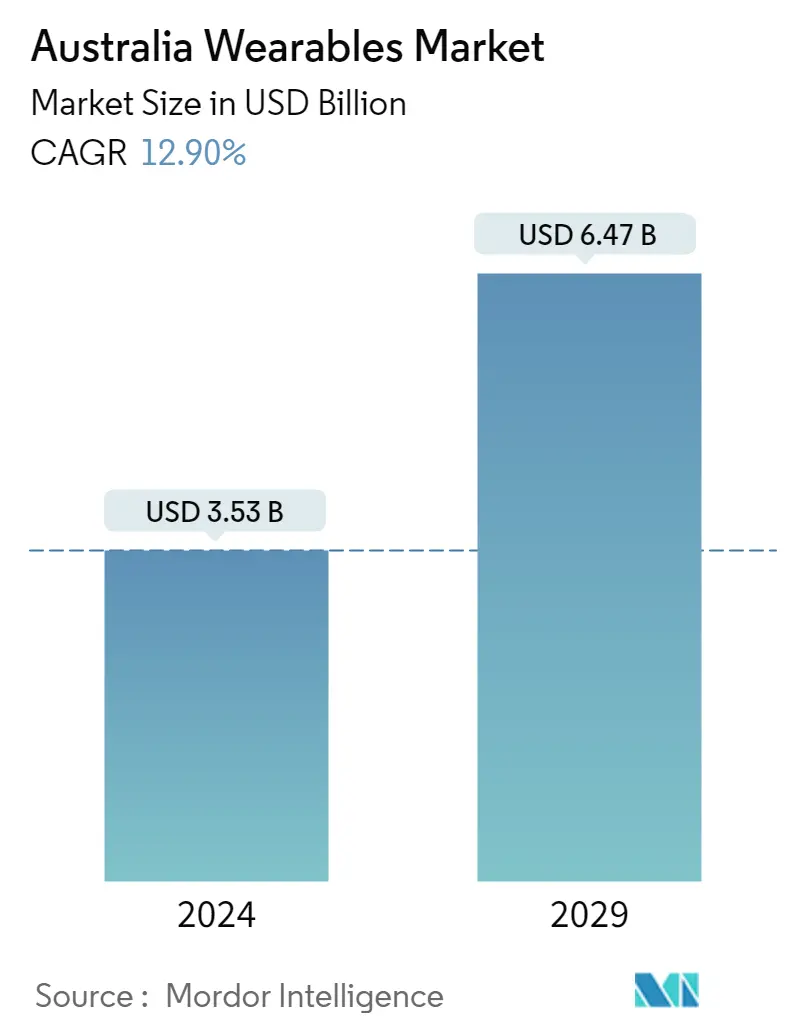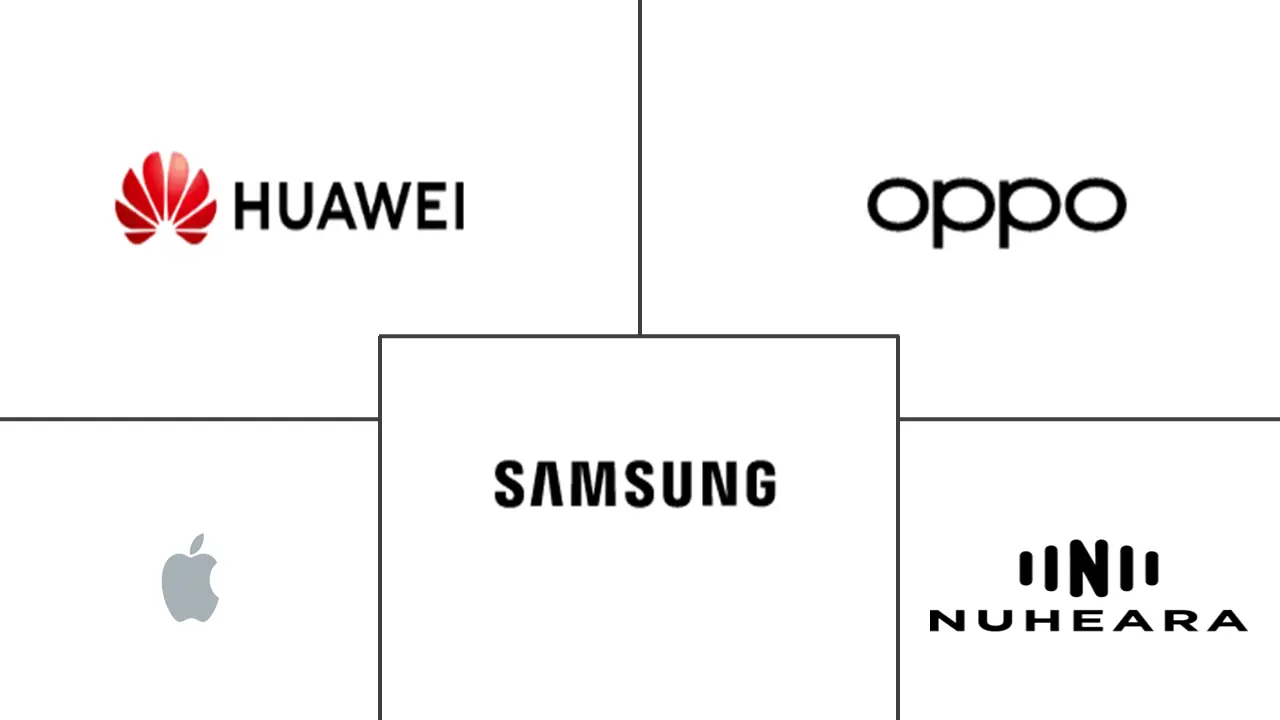Market Size of Australia Wearables Industry

| Study Period | 2019 - 2029 |
| Base Year For Estimation | 2023 |
| Market Size (2024) | USD 3.53 Billion |
| Market Size (2029) | USD 6.47 Billion |
| CAGR (2024 - 2029) | 12.90 % |
| Market Concentration | Low |
Major Players
*Disclaimer: Major Players sorted in no particular order |
Australia Wearables Market Analysis
The Australia Wearables Market size is estimated at USD 3.53 billion in 2024, and is expected to reach USD 6.47 billion by 2029, growing at a CAGR of 12.90% during the forecast period (2024-2029).
Smart wearable devices offer many features, including managing daily tasks, fitness tracking, checking emails, making contactless payments, etc. Hence, the change in consumer lifestyle and rising awareness of advanced technology will influence the growth of this market.
- The wearable market in Australia is rapidly increasing due to the rapid adoption of advanced technologies into wearable devices such as a wristband, eyewear, and watch. These technologically advanced products are used in the military, health and wellness, and the fitness of general people.
- Additionally, researchers and technology companies in Australia have been focusing on pandemic contact tracing using wearables. Several vital vendors also focused on this opportunity to grab the market potential during this unprecedented time. For instance, the Australian scale-up RightCrowd announced Right Crowd HQ to create awareness among company staff, monitor all close contact events, and store that data.
- However, the high manufacturing cost and the shorter lifecycle of these electronic products pose a significant threat to the wearables market. Furthermore, the manufacturer of wearable devices has to spend hugely on research and development, marketing, the promotion, which incurs a considerable cost for several manufacturers. So, a rapidly changing technological environment and high prices can influence the growth of this market.
- Moreover, rising awareness about health concerns among the Australian people is fuelling the growth of the wearables market. The COVID-19 pandemic crisis has expanded the role of wearable devices in the healthcare sector. These wearable products can offer different information types, including blood pressure, oxygen levels, quality and quantity of sleep, calorie intake, cholesterol levels, etc. However, data piracy threats are restraining the growth of this market.
Australia Wearables Industry Segmentation
The wearables include the devices such as smartwatches and fitness trackers, among others, that are worn by users of various age groups on their bodies. The market size comprises the value of wearable devices sold by various vendors in the market.
The Australia Wearables Market is segmented by End-User (Babies, Kids, Adults, Elderly) and by Product (Smartwatches, Head Mounted Displays, Ear Worn, Fitness Trackers/Activity Trackers). The market sizes and forecasts are provided in terms of value (USD million) for all the above segments. The vast availability of smart devices, including tablets, smartwatches, and fitness/activity trackers in the country, supports the growth of the wearable devices market.
| By End-user | |
| Babies | |
| Kids | |
| Adults | |
| Elderly |
| By Product | |
| Smartwatches | |
| Head Mounted Displays | |
| Ear Worn | |
| Fitness Trackers/Activity Trackesr | |
| Other Wearables |
Australia Wearables Market Size Summary
The Australia wearables market is experiencing significant growth, driven by the increasing adoption of smart wearable devices that offer features such as fitness tracking, contactless payments, and task management. This growth is largely attributed to changing consumer lifestyles and heightened awareness of advanced technologies. The market is expanding rapidly due to the integration of these technologies into various sectors, including military, health, and wellness. The COVID-19 pandemic has further accelerated this trend, with wearables being utilized for contact tracing and health monitoring. However, challenges such as high manufacturing costs, shorter product lifecycles, and data security concerns pose potential threats to market expansion.
The demand for wearable devices, particularly head-mounted displays, is bolstered by the growing gaming industry and increased interest in virtual and augmented reality experiences. The reduction in component costs and advancements in lightweight technology have facilitated innovation in this space. Additionally, the defense sector's investment in advanced military applications presents substantial opportunities for growth. Major players in the market, including Huawei, Oppo, Apple, and Samsung, are continuously innovating to differentiate their offerings and expand their consumer base. Collaborations and product launches, such as those by Google Cloud with Fitbit and Samsung's Galaxy Watch5, highlight the ongoing efforts to integrate wearable technology into everyday health and wellness routines.
Australia Wearables Market Size - Table of Contents
-
1. MARKET INSIGHTS
-
1.1 Market Overview
-
1.2 Industry Attractiveness - Porter's Five Forces Analysis
-
1.2.1 Bargaining Power of Suppliers
-
1.2.2 Bargaining Power of Consumers
-
1.2.3 Threat of New Entrants
-
1.2.4 Threat of Substitutes
-
1.2.5 Intensity of Competitive Rivalry
-
-
1.3 Impact of COVID-19 on the Australia Wearables Market
-
-
2. MARKET SEGMENTATION
-
2.1 By End-user
-
2.1.1 Babies
-
2.1.2 Kids
-
2.1.3 Adults
-
2.1.4 Elderly
-
-
2.2 By Product
-
2.2.1 Smartwatches
-
2.2.2 Head Mounted Displays
-
2.2.3 Ear Worn
-
2.2.4 Fitness Trackers/Activity Trackesr
-
2.2.5 Other Wearables
-
-
Australia Wearables Market Size FAQs
How big is the Australia Wearables Market?
The Australia Wearables Market size is expected to reach USD 3.53 billion in 2024 and grow at a CAGR of 12.90% to reach USD 6.47 billion by 2029.
What is the current Australia Wearables Market size?
In 2024, the Australia Wearables Market size is expected to reach USD 3.53 billion.

